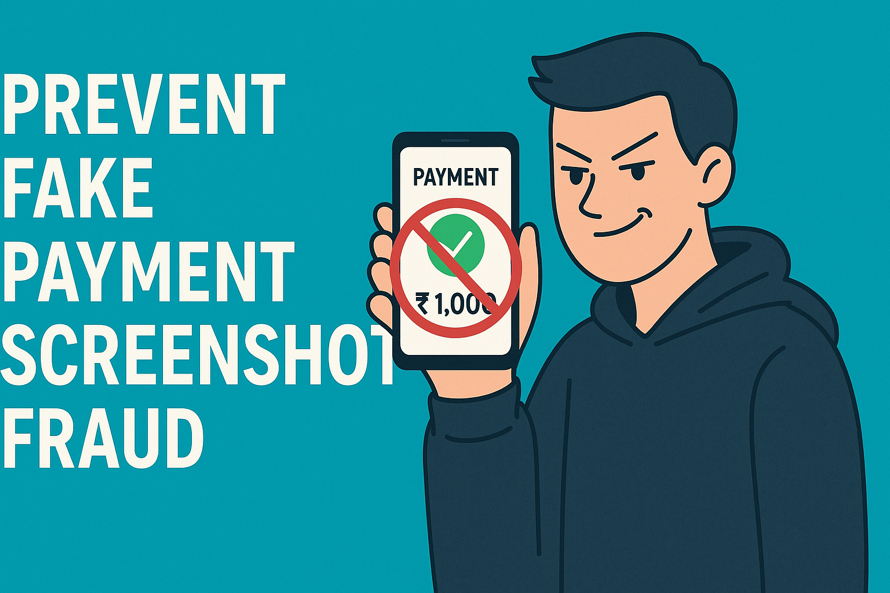
In the digital age, a business can accept payment via UPI, wallets, or net banking. However, one of the major issues plaguing UPI payments is fraudulent payment screenshots. Here, scammers display modified or fake screenshots to make sellers believe that they have made a payment. This may result in monetary loss and loss of trust. To be safe, you should verify real-time payment confirmation with your bank.
Such scams are best avoided by using automated systems and secure payment gateways. Your business can also be safeguarded by educating staff and checking every transaction. These measures are imperative to prevent fake payment screenshot fraud and ensure hassle-free and safe online transactions. Let’s dig in to learn more.
What is Fake Payment Screenshot Fraud and Why It’s Rising
Today, everything is digital, and UPI and instant payments have simplified transactions in the blink of an eye. However, there is a growing danger with such convenience. In this scheme, fraudsters will present sellers with fake screenshots of successful payments to scam them.
The Role of UPI and Real-Time Digital Payments
In India, UPI and digital wallets are popular and used to make quick payments. Fraudsters exploit the trust and speed of the system. They make counterfeit screenshots, which appear authentic, to shopkeepers and businesses to prove that they have paid.
Common Victims: From Local Vendors to Large Merchants
Even big stores can fall victim, not to mention street vendors and cab drivers. During rush hours, they lack the time and devices to check the payments appropriately. Scammers exploit this urgency. The state of Maharashtra in India had the most incidents involving the creation of fake digital profiles in 2022, with about 48 cases reported to the authorities.
Why Visual Confirmation Is a Dangerous Vulnerability
Most sellers just glance at the customer’s phone screen for confirmation. This is not a secure way. Simple tools may be used to edit screenshots. To prevent fake payment screenshot fraud, confirm payments in your app or POS.
Common Techniques Used by Fraudsters
Online payment is fast and convenient, yet it allows for a new form of crime. The following are some of the commonly used means and how to stay vigilant to avoid fake payment screenshot scams.
Edited Screenshots and Fake Payment Apps
Scammers usually use photo editing apps to modify genuine payment screenshots. Others continue to use fake UPI/bank apps that display realistic confirmation pages. These can easily fool shopkeepers or delivery agents who merely depend on visual confirmation.
Delayed or Cancelled Transactions
The second trick is to make a payment and display the screen to the seller, then cancel it before it’s processed. The fact that UPI only takes seconds has prompted some fraudsters to come up with poor network-related excuses that slow the revelation of the truth.
HTML Source Code Manipulation
In this method, the HTML code of the payment confirmation page on a phone or a computer is modified to display a fraudulent transaction. It is technical and can dupe anybody unaware of such tricks.
Screen Recording and Sound Tricks
Fraudsters also use screen recordings or play UPI success tones to create a fake payment illusion. To avoid fraudulent screenshots of payment, always confirm payment using your own app or by SMS alert.
How to Spot a Fake Payment Screenshot
In the era of digitalization, scammers usually display false payment screenshots to deceive sellers. However, these screenshots do not represent real payments. It is important to learn how to check them to ensure safety and prevent fake payment screenshot fraud.
Verifying UPI Transaction ID, Timestamp, and Amount
Always compare the UPI transaction ID and time stamp with your bank statements. An actual payment will appear in your UPI app or SMS messages. If you do not see the transaction, it is probably fake.
Checking Sender Details and UPI IDs
Check the sender’s name and UPI ID. Scammers can operate with false or resembling names. Do not depend on the screenshot alone. Verify the information in your UPI app.
Identifying Visual Red Flags: Fonts, Blurring, Errors
Have a close look at the screenshot. The fake ones usually contain fonts that do not match, misspelled words, or blurred images. A red flag should be raised when viewing an image that appears to have been edited or of poor quality.
Using EXIF Metadata for Digital Image Verification
When you get the screenshot in digital form, you can examine its EXIF metadata. This can indicate whether the photo has been modified or produced using editing programs—another red flag of a scam.
Prevention Strategies for Individuals
Scammers often deceive individuals by presenting fictitious screenshots of UPI payments. The screenshots are made to appear real; however, no money is transferred. The following are simple methods of staying safe.
Best Practices for Verifying Digital Payments
To receive money, use the official UPI app to verify the receipt. In your transaction history, you should find a UTR (Unique Transaction Reference) number. Do not believe in payment confirmation messages or screenshots provided by the buyer.
Recognizing Common Scam Scenarios
Fraudsters can say that the payment is delayed or pending. Some can forward modified screenshots. Be suspicious when the buyer hurries you or requests an immediate delivery without possessing real credit.
Using Trusted UPI Apps and Notifications
Allow payment reminders on your phone. Use popular UPI applications only. Do not tap on unfamiliar links or install unofficial applications.
How Businesses Can Protect Themselves
Several small and large firms have lost money by believing in visual evidence rather than confirmed transactions. The following are the easy methods to avoid fake payment screenshot fraud.
Mandatory Payment Verification Protocols
Businesses should routinely countercheck all payments using the official bank application or merchant dashboard. Avoid using screenshots alone for payment verification. Always meet the transaction ID and confirmation message from the bank or UPI system.
Real-Time Alerts and Dedicated UPI Accounts
Enable real-time SMS or app notifications on inbound payments. Receive payment through a special UPI account. This simplifies the tracking and verification of every transaction quickly.
Training Staff to Spot Red Flags
Employees need to learn how to detect fraudulent applications, screenshots, or payment delays. Educate them to verify every transaction before delivering goods or services. Regular awareness training may minimize fraud risks.
Using Secure QR Codes, Smart Soundboxes, and APIs
Apply certified QR codes, intelligent soundboxes, and authorized UPI APIs. Such tools provide confirmation sounds or messages in real time, providing an additional level of safety and efficiency to prevent fake payment screenshot fraud.
Technology Solutions for Payment Verification
To prevent fake payment screenshot fraud, new technological solutions currently assist in verifying payments in real time and safely. Some tried and tested technology solutions are given below.
Secure QR Code Systems (e.g., Qryptal)
Qryptal provides safe and tamper-evident QR codes. These are digitally signed and encrypted. When they are scanned, they immediately verify if the payment is genuine. This assists companies in preventing visual checks alone.
Real-Time UPI Verification APIs (e.g., Surepass, Cashfree)
UPI transaction verifying platforms such as Surepass and Cashfree offer APIs that can verify UPI transactions in real time. They will check whether the money has actually been deposited into the account. This eliminates manual confirmation processes and guesswork.
Identity Verification Tools (e.g., Instantpay, Cashfree)
These tools ensure that the payer’s identity is matched with UPI or account information. This guards against fraudulent identities and misaligned identities. Immediate authentication establishes the trust between the buyer and seller.
AI and Machine Learning for Detecting Image Manipulation
Even sophisticated AI is capable of noticing signs of photo editing on payment screenshots. These systems check inconsistencies, edited data, or duplicated photos. This assists companies in spotting fraudulent screenshots before it’s too late.
Legal Ramifications and Reporting in India
A relatively new issue in the digital era is fake payment screenshot fraud. Understanding the legal procedure and the process of reporting it can help prevent fake payment screenshot fraud.
IPC and IT Act Provisions on Payment Fraud
Digital payment frauds are addressed under the India Penal Code and also under the IT Act. Sections 419, 420, and 468 of the IPC deal with cheating and forgery. The IT Act handles cybercrimes, and Sections 66C and 66D deal with identity theft and personation associated with digital frauds.
Where and How to Report Cybercrime in Bengaluru
To fight increasing cybercrimes, Bengaluru established the Cyber Crime Police Station in March 2017 under the office of the Police Commissioner. Also, eight CEN police posts were established to address cyber, economic, and narcotic-related crimes within the city.
What Evidence to Collect Before Filing a Report
Collect the fake payment screenshot, transaction ID, chat history, phone numbers, and CCTV footage. These facts help officials in tracing and acting more swiftly. It is always important to move fast to enhance recovery.
Conclusion: Building a Fraud-Resistant Payment Ecosystem
Establishing a payment ecosystem resistant to fraud is extremely important in the digital world. Along with the increasing use of UPI and real-time payments, fraud risks are also rising. Companies should employ high-security payment gateways and verification systems in real time.
A high level of cybersecurity and periodic audits can identify vulnerable spots. Users and merchants should be vigilant and informed to prevent fake payment screenshot fraud. By joining forces, we will be able to build a safer payment environment where trust and technology will cooperate to prevent fraud even before it occurs.
FAQs
Q. What is fake payment screenshot fraud?
Fake payment screenshot fraud occurs when a scammer presents an edited screenshot of a supposedly successful payment to dupe a seller into believing that a digital transaction has been made.
Q. Can a fake payment screenshot show a successful UPI transaction?
Fraudsters can edit or make a fake UPI screenshot that looks real. They are images that usually resemble the actual transaction messages, but the money is not transferred.
Q. What is the safest way to confirm digital payments?
It is always safer to check your bank account, UPI app, or POS machine to see a live transaction notification before you deliver goods or services.
Q. How can merchants detect fake screenshots quickly?
Merchants are requested to never trust transactions without checking them in their UPI app or bank alerts. False screenshots will more likely not correspond with actual transaction IDs or timestamps.
Q. Is it legal to use a fake payment app or screenshot in India?
No, faking payment apps or screenshots is not legal under Indian cyber laws. It is considered a form of fraud and is punishable by criminal prosecution and imprisonment.
Q. What should I do if I fall victim to payment screenshot fraud?
Notify the police and your bank about the incident as soon as possible. Submit the evidence, such as CCTV footage, the phone number, and the fake screenshot, to investigate the fraud.
Q. Are there apps that verify UPI transactions in real time?
Yes, UPI applications such as Google Pay, PhonePe, and Paytm provide real-time alerts. Official dashboards are also available to merchants to get the immediate payment status.
Q. What are smart soundboxes, and how do they help in fraud prevention?
Intelligent soundboxes provide immediate audio notification of a received payment. They aid in verifying actual transactions and help avoid fraud by using false screenshots or other untrue claims.







